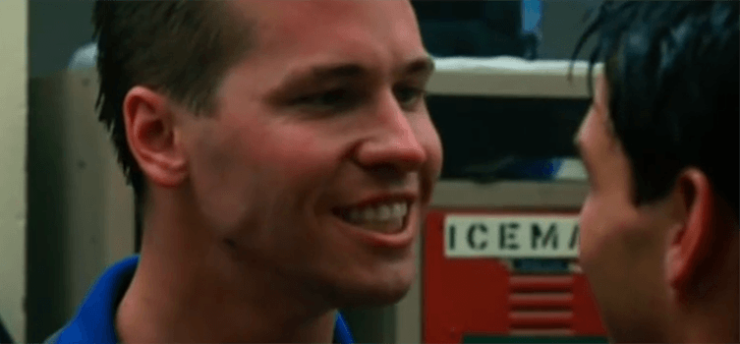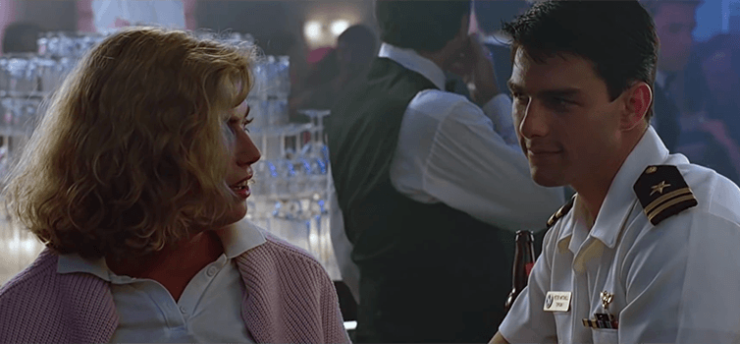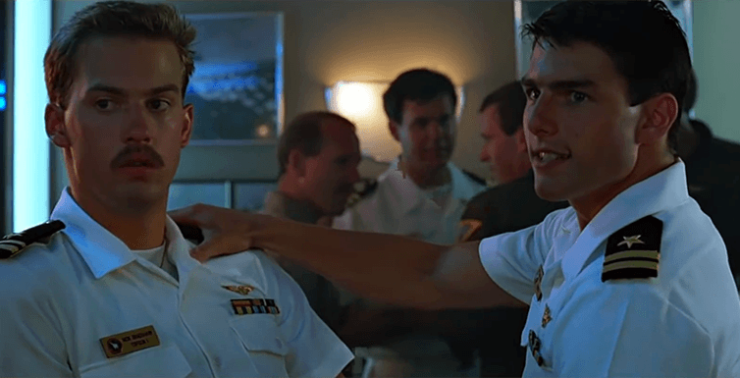Top Gun is a motion picture. Say what you will about it: it’s a film, and that’s undeniable. When Tony Scott settled into the director’s chair on the set of Top Gun and shouted “action” into a cartoony metal bullhorn, there’s no doubt that he knew he was about to do some cinema at American audiences. There’s also no doubt that he knew exactly what kind of movie he was about to produce: a cautionary tale of heterosexual tragedy.
(Michael Bay was 21 years old when Top Gun came out in theaters. His directorial debut came just nine years later, with the movie Bad Boys, which was also a Bruckheimer/Simpson picture. In the interim, Bay had time for over 42,000 screenings of Top Gun. It explains a lot. It explains Armageddon, which usually defies understanding. I’m not here today to talk about Michael Bay, but it was important to me that you all read that number. Anyway: Top Gun.)
Top Gun is a heartfelt, moving film about one man’s risky dalliance with heterosexuality. Lieutenant Tom “Maverick” Cruise is introduced to the audience as a glistening, patriotic risk-taker. He just wants to be the best Plane Guy he can be. His ambitious Airplane Moves get him all the way to the TOPGUN program, a school for only the coolest plane guys. Everything is going great for Maverick… until the night before classes begin. He arrives at Miramar, where the TOPGUN program is located, as ominous music plays in the background—Maverick, the score informs us, is on the highway to the danger zone.
That very evening, Maverick’s sassy straight friend, Lieutenant j.g. Goose “Goose” Goose, brings him to a straight bar for an evening of exploration. Goose exhorts the tentative Maverick to “have carnal knowledge—of a lady this time—on the premises.”

Maverick is understandably reluctant to engage in behavior as risky and unnatural as picking up a woman at a bar, but alcohol lowers his inhibitions enough that he sings the song “You’ve Lost That Lovin’ Feeling,” a heterosexual anthem about the death of affection in a long-term relationship. The woman rebuffs his advances, but that doesn’t matter. Maverick has tasted the forbidden fruit that is heterosexuality, and he wants more.
Maverick spends the remainder of Top Gun doing two things: practicing Cool Airplane Moves and experimenting with heterosexual behavior. The Cool Airplane Moves speak for themselves: this is the blatant-Navy-recruitment part of the film, and it’s all about sweaty guys Using Lingo and going fyooom. Meanwhile, the sections of the film that take place on the ground follow Maverick’s struggle with the urge to blatantly disrespect a woman into having sex with him.
Throughout the film, Maverick’s colleagues do their best to steer him away from this dark and dangerous path. Notably, Val “Iceman” Kilmer tries to intercede, repeatedly telling Maverick that he and his risky behavior are dangerous. Iceman is the best Plane Guy at TOPGUN, and it is from this position of authority that he offers counsel: “You never, never leave your wingman, Maverick.”

Although Iceman is adamant throughout the film that Maverick needs to shape up, his advice isn’t enough to keep Maverick from succumbing to heterosexual temptation. By the time Iceman delivers his stand-by-your-man speech, it’s too late: Maverick is already in a relationship with Charlie, the flight instructor he tried to seduce on his excursion to the straight bar at the beginning of the movie. (Charlie is played by Kelly McGillis, whose brave portrayal of heterosexuality is both honest and touching.)
The relationship is a predatory one—Charlie is in a position of institutional authority over Maverick, and acknowledges as much throughout the film—and thus must be kept a secret. Charlie and Maverick are only able to engage in heterosexual behavior in the straight bars that Goose and his visiting wife like to haunt, lawless clubs where women shout for piano-playing men to ‘take them to bed or lose them forever.’ Poor Maverick is so drawn in by the freewheeling atmosphere of his new underground lifestyle that he completely ignores the dangerous power dynamic inherent in his relationship with Charlie, going so far as to abandon his wingman during a healthful game of sweaty, shirtless beach volleyball to pursue her. The wholesomeness of this scene is underlined by the score, which here features the Kenny Loggins song Playing With the Boys. Even Goose—the so-called ‘friend’ who initially encourages Maverick to try out the straight lifestyle—begs Maverick not to stop playing with the boys…but this is a lesson Maverick must learn for himself.
He continues to experiment with heterosexuality, until finally, he’s forced to reevaluate his life and choices. Goose meets a tragic end during a scene where some very cool Airplane Moves go very wrong, and in that moment, the only definitely-heterosexual character in the film is gone. Although Goose’s death is accidental and unrelated to his lifestyle, it cannot be denied that his demise represents a heterosexual tragedy. Without his influence, Maverick struggles to find direction—in his career and in his relationship with Charlie.

Maverick spends the final act of the film engaging with this struggle. His chief instructor, Viper, tells him not to waste too much time mourning the loss of Goose. “You fly jets long enough,” he tells Maverick, “something like this happens.” He is, of course, obliquely informing Maverick that Goose’s death should not have been surprising: the lifestyle he led was a risky one, and to mourn him too dearly would be a mistake.
This advice seems to come within a few hours of Goose’s death, and in the days that follow, Maverick grapples with what to do next. He packs up Goose’s things and delivers them to his dead friend’s widow, witnessing her grief firsthand. In the wake of this, even as he wrestles with his future at TOPGUN, he ends his relationship with Charlie. In the scene where he breaks up with her and threatens to leave the TOPGUN program, he drinks ice water—a choice that indicates his acceptance of Iceman’s principles.
In the end, Maverick graduates from the TOPGUN program and is immediately deployed to active duty. He participates in some Airplane Fighting alongside Iceman, and the two function as a team, winning the battle. They’re a good Plane Team, and when the explosions are over, Iceman expresses immense relief at the prodigal Maverick’s return. “You can be my wingman any time,” Iceman says, welcoming Maverick back into the fold and demonstrating forgiveness of his comrade’s reckless experimentation with heterosexuality. Maverick gratefully accepts this amnesty, and finalizes his commitment to abandoning Goose’s path by hurling his old friend’s dog tags into the sea.
Viewers of Top Gun may think that they can rest at this point of the film—but of course, no summer blockbuster can resist a stinger scene. Just before the credits roll, Maverick returns to the TOPGUN program as an instructor, a decision which reunites him with Charlie. In this, the film offers a nuanced portrayal of the ongoing struggle one must endure when resisting the persistent draw of heterosexual behavior. One can only hope that, when faced with temptation, Maverick will stick to his Top Guns.

(I could have written an essay about how Top Gun is fascist propaganda. It’s all there: a might-makes-right mentality, military fetishism, brotherhood-and-citizenship-through-combat, disdain for the validity of other nations’ sovereign borders, faceless aggressors who must die at all costs, the romanticization of the disregard for diplomatic regulations in favor of heroism which supports nationalistic goals… I could go on for a while. The problem is that, while Top Gun was an immensely successful tool of naval recruitment, it’s an abysmal failure of a propaganda film. It lacks awareness of the social contexts that make it possible for a movie like this one to become a classic of queer cinema, and because this movie doesn’t know how to engage with those contexts and communities, it can’t function as a tool to reinforce the social rules it wants to. Sorry, Top Gun. I know you tried to promote fascist ideals of the nobility of war—but instead, you promoted glistening boys playing volleyball and showering together. Personally, I can’t think of a better example of failing upward. Reader… it takes my breath away.)
 Hugo, Nebula, and Campbell award finalist Sarah Gailey is an internationally-published writer of fiction and nonfiction. Their work has recently appeared in Mashable, the Boston Globe, and Fireside Fiction. They are a regular contributor for Tor.com and Barnes & Noble. You can find links to their work here. They tweet @gaileyfrey. Their American Hippo novella series—River of Teeth and Taste of Marrow—is available from Tor.com, and their upcoming novel Magic For Liars publishes June 2019.
Hugo, Nebula, and Campbell award finalist Sarah Gailey is an internationally-published writer of fiction and nonfiction. Their work has recently appeared in Mashable, the Boston Globe, and Fireside Fiction. They are a regular contributor for Tor.com and Barnes & Noble. You can find links to their work here. They tweet @gaileyfrey. Their American Hippo novella series—River of Teeth and Taste of Marrow—is available from Tor.com, and their upcoming novel Magic For Liars publishes June 2019.










